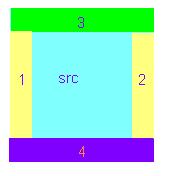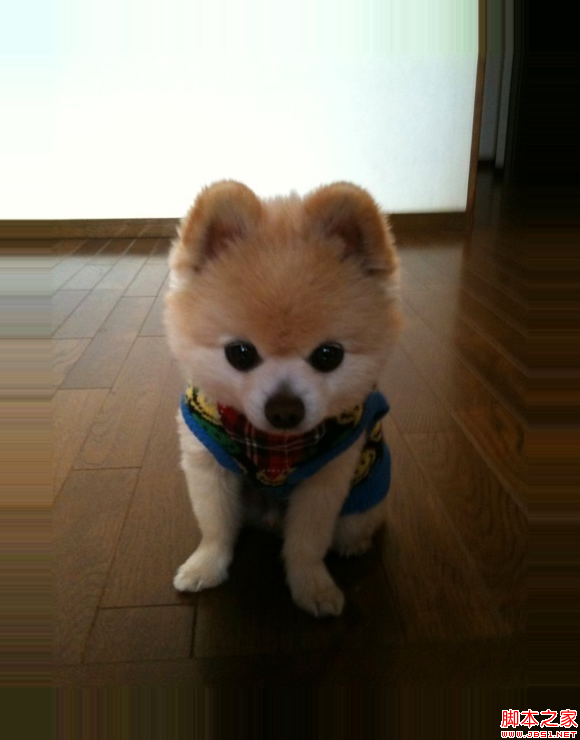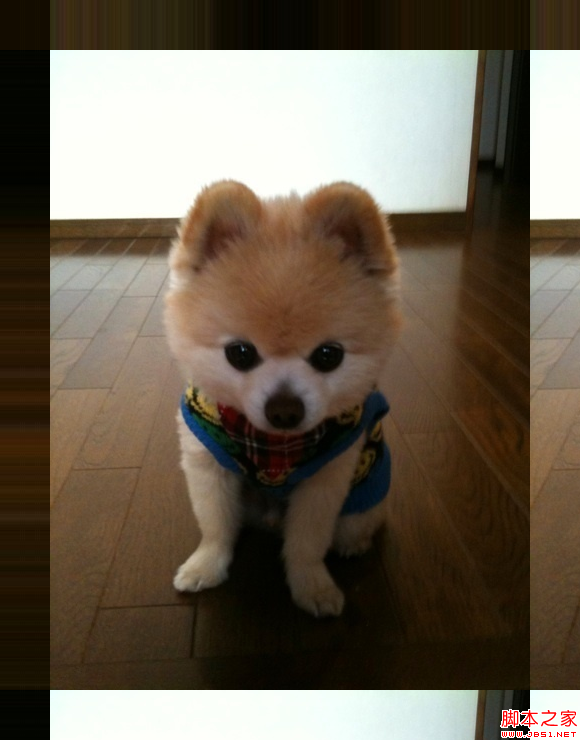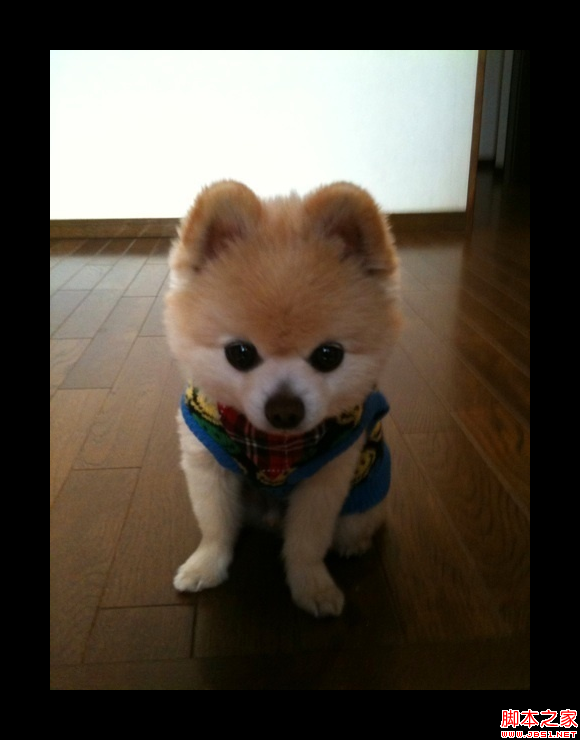上一篇文章,我们来给矩阵添加一些常用方法,这篇文章将讲解图像的虚拟边缘。
虚拟边缘
虚拟边缘就是按照一定映射关系,给图像添加边缘。
那么虚拟边缘有什么用呢?比如可以很容易做一个倒影的效果:

当然这只是附带效果了,虚拟边缘主要用在图像卷积运算(例如平滑操作)时候,由于卷积运算的特点,需要将图片扩大才能对边角进行卷积运算,这时候就需要对图片进行预处理,添加虚拟边缘。
说白了,就是在一些图片处理前进行预处理。
边缘类型
这里参考OpenCV相关文档的边缘描述:
/*
Various border types, image boundaries are denoted with '|'
* BORDER_REPLICATE: aaaaaa|abcdefgh|hhhhhhh
* BORDER_REFLECT: fedcba|abcdefgh|hgfedcb
* BORDER_REFLECT_101: gfedcb|abcdefgh|gfedcba
* BORDER_WRAP: cdefgh|abcdefgh|abcdefg
* BORDER_CONSTANT: iiiiii|abcdefgh|iiiiiii with some specified 'i'
*/
举个例子BODER_REFLECT就是对于某一行或某一列像素点:
abcdefgh
其左的虚拟边缘对应为fedcba,右边对应为hgfedcb,也就是反射映射。上图就是通过对图片底部进行添加BORDER_REFLECT类型的虚拟边缘得到的。
而BORDER_CONSTANT则是所有边缘都是固定值i。
实现
因为BORDER_CONSTANT比较特殊,所以和其他类型分开处理。
function copyMakeBorder(__src, __top, __left, __bottom, __right, __borderType, __value){
if(__src.type != "CV_RGBA"){
console.error("不支持类型!");
}
if(__borderType === CV_BORDER_CONSTANT){
return copyMakeConstBorder_8U(__src, __top, __left, __bottom, __right, __value);
}else{
return copyMakeBorder_8U(__src, __top, __left, __bottom, __right, __borderType);
}
};
这个函数接受一个输入矩阵src,每个方向要添加的像素大小top,left,bottom,right,边缘的类型borderType,还有一个数组value,即如果是常数边缘时候添加的常数值。
然后我们引入一个边缘的映射关系函数borderInterpolate。
function borderInterpolate(__p, __len, __borderType){
if(__p = __len){
switch(__borderType){
case CV_BORDER_REPLICATE:
__p = __p break;
case CV_BORDER_REFLECT:
case CV_BORDER_REFLECT_101:
var delta = __borderType == CV_BORDER_REFLECT_101;
if(__len == 1)
return 0;
do{
if(__p __p = -__p - 1 + delta;
else
__p = __len - 1 - (__p - __len) - delta;
}while(__p = __len)
break;
case CV_BORDER_WRAP:
if(__p __p -= ((__p - __len + 1) / __len) * __len;
if(__p >= __len)
__p %= __len;
break;
case CV_BORDER_CONSTANT:
__p = -1;
default:
error(arguments.callee, UNSPPORT_BORDER_TYPE/* {line} */);
}
}
return __p;
};
这个函数的意义是对于原长度为len的某一行或者某一列的虚拟像素点p(p一般是负数或者大于或等于该行原长度的数,负数则表示该行左边的像素点,大于或等于原长度则表示是右边的像素点),映射成这一行的哪一个像素点。我们拿CV_BORDER_REPLICATE分析一下,其表达式是:
__p = __p 也就是说p为负数时(也就是左边)的时候映射为0,否则映射成len - 1。
然后我们来实现copyMakeBorder_8U函数:
function copyMakeBorder_8U(__src, __top, __left, __bottom, __right, __borderType){
var i, j;
var width = __src.col,
height = __src.row;
var top = __top,
left = __left || __top,
right = __right || left,
bottom = __bottom || top,
dstWidth = width + left + right,
dstHeight = height + top + bottom,
borderType = borderType || CV_BORDER_REFLECT;
var buffer = new ArrayBuffer(dstHeight * dstWidth * 4),
tab = new Uint32Array(left + right);
for(i = 0; i tab[i] = borderInterpolate(i - left, width, __borderType);
}
for(i = 0; i tab[i + left] = borderInterpolate(width + i, width, __borderType);
}
var tempArray, data;
for(i = 0; i tempArray = new Uint32Array(buffer, (i + top) * dstWidth * 4, dstWidth);
data = new Uint32Array(__src.buffer, i * width * 4, width);
for(j = 0; j tempArray[j] = data[tab[j]];
for(j = 0; j tempArray[j + width + left] = data[tab[j + left]];
tempArray.set(data, left);
}
var allArray = new Uint32Array(buffer);
for(i = 0; i j = borderInterpolate(i - top, height, __borderType);
tempArray = new Uint32Array(buffer, i * dstWidth * 4, dstWidth);
tempArray.set(allArray.subarray((j + top) * dstWidth, (j + top + 1) * dstWidth));
}
for(i = 0; i j = borderInterpolate(i + height, height, __borderType);
tempArray = new Uint32Array(buffer, (i + top + height) * dstWidth * 4, dstWidth);
tempArray.set(allArray.subarray((j + top) * dstWidth, (j + top + 1) * dstWidth));
}
return new Mat(dstHeight, dstWidth, new Uint8ClampedArray(buffer));
}
这里需要解释下,边缘的复制顺序是:先对每行的左右进行扩展,然后在此基础上进行上下扩展,如图所示。

然后我们根据ArrayBuffer的性质,将数据转成无符号32位整数来操作,这样每个操作单位就对应了每个像素点了。什么意思?
比如对于某个像素点:RGBA,由于某个通道是用无符号8为整数来存储的,所以实际上一个像素点则对应了32位的存储大小,由于ArrayBuffer的性质,可以将数据转成任意类型来处理,这样我们就可以通过转成Uint32Array类型,将数据变成每个像素点的数据数组。
那么copyMakeConstBorder_8U就比较容易实现了:
function copyMakeConstBorder_8U(__src, __top, __left, __bottom, __right, __value){
var i, j;
var width = __src.col,
height = __src.row;
var top = __top,
left = __left || __top,
right = __right || left,
bottom = __bottom || top,
dstWidth = width + left + right,
dstHeight = height + top + bottom,
value = __value || [0, 0, 0, 255];
var constBuf = new ArrayBuffer(dstWidth * 4),
constArray = new Uint8ClampedArray(constBuf);
buffer = new ArrayBuffer(dstHeight * dstWidth * 4);
for(i = 0; i for( j = 0; j constArray[i * 4 + j] = value[j];
}
}
constArray = new Uint32Array(constBuf);
var tempArray;
for(i = 0; i tempArray = new Uint32Array(buffer, (i + top) * dstWidth * 4, left);
tempArray.set(constArray.subarray(0, left));
tempArray = new Uint32Array(buffer, ((i + top + 1) * dstWidth - right) * 4, right);
tempArray.set(constArray.subarray(0, right));
tempArray = new Uint32Array(buffer, ((i + top) * dstWidth + left) * 4, width);
tempArray.set(new Uint32Array(__src.buffer, i * width * 4, width));
}
for(i = 0; i tempArray = new Uint32Array(buffer, i * dstWidth * 4, dstWidth);
tempArray.set(constArray);
}
for(i = 0; i tempArray = new Uint32Array(buffer, (i + top + height) * dstWidth * 4, dstWidth);
tempArray.set(constArray);
}
return new Mat(dstHeight, dstWidth, new Uint8ClampedArray(buffer));
}
效果图
CV_BORDER_REPLICATE

CV_BORDER_REFLECT

CV_BORDER_WRAP

CV_BORDER_CONSTANT

 JavaScript -Engines: Implementierungen vergleichenApr 13, 2025 am 12:05 AM
JavaScript -Engines: Implementierungen vergleichenApr 13, 2025 am 12:05 AMUnterschiedliche JavaScript -Motoren haben unterschiedliche Auswirkungen beim Analysieren und Ausführen von JavaScript -Code, da sich die Implementierungsprinzipien und Optimierungsstrategien jeder Engine unterscheiden. 1. Lexikalanalyse: Quellcode in die lexikalische Einheit umwandeln. 2. Grammatikanalyse: Erzeugen Sie einen abstrakten Syntaxbaum. 3. Optimierung und Kompilierung: Generieren Sie den Maschinencode über den JIT -Compiler. 4. Führen Sie aus: Führen Sie den Maschinencode aus. V8 Engine optimiert durch sofortige Kompilierung und versteckte Klasse.
 Jenseits des Browsers: JavaScript in der realen WeltApr 12, 2025 am 12:06 AM
Jenseits des Browsers: JavaScript in der realen WeltApr 12, 2025 am 12:06 AMZu den Anwendungen von JavaScript in der realen Welt gehören die serverseitige Programmierung, die Entwicklung mobiler Anwendungen und das Internet der Dinge. Die serverseitige Programmierung wird über node.js realisiert, die für die hohe gleichzeitige Anfrageverarbeitung geeignet sind. 2. Die Entwicklung der mobilen Anwendungen erfolgt durch reaktnative und unterstützt die plattformübergreifende Bereitstellung. 3.. Wird für die Steuerung von IoT-Geräten über die Johnny-Five-Bibliothek verwendet, geeignet für Hardware-Interaktion.
 Erstellen einer SaaS-Anwendung mit mehreren Mietern mit Next.js (Backend Integration)Apr 11, 2025 am 08:23 AM
Erstellen einer SaaS-Anwendung mit mehreren Mietern mit Next.js (Backend Integration)Apr 11, 2025 am 08:23 AMIch habe eine funktionale SaaS-Anwendung mit mehreren Mandanten (eine EdTech-App) mit Ihrem täglichen Tech-Tool erstellt und Sie können dasselbe tun. Was ist eine SaaS-Anwendung mit mehreren Mietern? Mit Multi-Tenant-SaaS-Anwendungen können Sie mehrere Kunden aus einem Sing bedienen
 So erstellen Sie eine SaaS-Anwendung mit mehreren Mietern mit Next.js (Frontend Integration)Apr 11, 2025 am 08:22 AM
So erstellen Sie eine SaaS-Anwendung mit mehreren Mietern mit Next.js (Frontend Integration)Apr 11, 2025 am 08:22 AMDieser Artikel zeigt die Frontend -Integration mit einem Backend, das durch die Genehmigung gesichert ist und eine funktionale edtech SaaS -Anwendung unter Verwendung von Next.js. erstellt. Die Frontend erfasst Benutzerberechtigungen zur Steuerung der UI-Sichtbarkeit und stellt sicher, dass API-Anfragen die Rollenbasis einhalten
 JavaScript: Erforschung der Vielseitigkeit einer WebspracheApr 11, 2025 am 12:01 AM
JavaScript: Erforschung der Vielseitigkeit einer WebspracheApr 11, 2025 am 12:01 AMJavaScript ist die Kernsprache der modernen Webentwicklung und wird für seine Vielfalt und Flexibilität häufig verwendet. 1) Front-End-Entwicklung: Erstellen Sie dynamische Webseiten und einseitige Anwendungen durch DOM-Operationen und moderne Rahmenbedingungen (wie React, Vue.js, Angular). 2) Serverseitige Entwicklung: Node.js verwendet ein nicht blockierendes E/A-Modell, um hohe Parallelitäts- und Echtzeitanwendungen zu verarbeiten. 3) Entwicklung von Mobil- und Desktop-Anwendungen: Die plattformübergreifende Entwicklung wird durch reaktnative und elektronen zur Verbesserung der Entwicklungseffizienz realisiert.
 Die Entwicklung von JavaScript: Aktuelle Trends und ZukunftsaussichtenApr 10, 2025 am 09:33 AM
Die Entwicklung von JavaScript: Aktuelle Trends und ZukunftsaussichtenApr 10, 2025 am 09:33 AMZu den neuesten Trends im JavaScript gehören der Aufstieg von Typenkripten, die Popularität moderner Frameworks und Bibliotheken und die Anwendung der WebAssembly. Zukunftsaussichten umfassen leistungsfähigere Typsysteme, die Entwicklung des serverseitigen JavaScript, die Erweiterung der künstlichen Intelligenz und des maschinellen Lernens sowie das Potenzial von IoT und Edge Computing.
 Entmystifizieren JavaScript: Was es tut und warum es wichtig istApr 09, 2025 am 12:07 AM
Entmystifizieren JavaScript: Was es tut und warum es wichtig istApr 09, 2025 am 12:07 AMJavaScript ist der Eckpfeiler der modernen Webentwicklung. Zu den Hauptfunktionen gehören eine ereignisorientierte Programmierung, die Erzeugung der dynamischen Inhalte und die asynchrone Programmierung. 1) Ereignisgesteuerte Programmierung ermöglicht es Webseiten, sich dynamisch entsprechend den Benutzeroperationen zu ändern. 2) Die dynamische Inhaltsgenerierung ermöglicht die Anpassung der Seiteninhalte gemäß den Bedingungen. 3) Asynchrone Programmierung stellt sicher, dass die Benutzeroberfläche nicht blockiert ist. JavaScript wird häufig in der Webinteraktion, der einseitigen Anwendung und der serverseitigen Entwicklung verwendet, wodurch die Flexibilität der Benutzererfahrung und die plattformübergreifende Entwicklung erheblich verbessert wird.
 Ist Python oder JavaScript besser?Apr 06, 2025 am 12:14 AM
Ist Python oder JavaScript besser?Apr 06, 2025 am 12:14 AMPython eignet sich besser für Datenwissenschaft und maschinelles Lernen, während JavaScript besser für die Entwicklung von Front-End- und Vollstapel geeignet ist. 1. Python ist bekannt für seine prägnante Syntax- und Rich -Bibliotheks -Ökosystems und ist für die Datenanalyse und die Webentwicklung geeignet. 2. JavaScript ist der Kern der Front-End-Entwicklung. Node.js unterstützt die serverseitige Programmierung und eignet sich für die Entwicklung der Vollstapel.


Heiße KI -Werkzeuge

Undresser.AI Undress
KI-gestützte App zum Erstellen realistischer Aktfotos

AI Clothes Remover
Online-KI-Tool zum Entfernen von Kleidung aus Fotos.

Undress AI Tool
Ausziehbilder kostenlos

Clothoff.io
KI-Kleiderentferner

AI Hentai Generator
Erstellen Sie kostenlos Ai Hentai.

Heißer Artikel

Heiße Werkzeuge

MinGW – Minimalistisches GNU für Windows
Dieses Projekt wird derzeit auf osdn.net/projects/mingw migriert. Sie können uns dort weiterhin folgen. MinGW: Eine native Windows-Portierung der GNU Compiler Collection (GCC), frei verteilbare Importbibliotheken und Header-Dateien zum Erstellen nativer Windows-Anwendungen, einschließlich Erweiterungen der MSVC-Laufzeit zur Unterstützung der C99-Funktionalität. Die gesamte MinGW-Software kann auf 64-Bit-Windows-Plattformen ausgeführt werden.

WebStorm-Mac-Version
Nützliche JavaScript-Entwicklungstools

SecLists
SecLists ist der ultimative Begleiter für Sicherheitstester. Dabei handelt es sich um eine Sammlung verschiedener Arten von Listen, die häufig bei Sicherheitsbewertungen verwendet werden, an einem Ort. SecLists trägt dazu bei, Sicherheitstests effizienter und produktiver zu gestalten, indem es bequem alle Listen bereitstellt, die ein Sicherheitstester benötigen könnte. Zu den Listentypen gehören Benutzernamen, Passwörter, URLs, Fuzzing-Payloads, Muster für vertrauliche Daten, Web-Shells und mehr. Der Tester kann dieses Repository einfach auf einen neuen Testcomputer übertragen und hat dann Zugriff auf alle Arten von Listen, die er benötigt.

Dreamweaver Mac
Visuelle Webentwicklungstools

Sicherer Prüfungsbrowser
Safe Exam Browser ist eine sichere Browserumgebung für die sichere Teilnahme an Online-Prüfungen. Diese Software verwandelt jeden Computer in einen sicheren Arbeitsplatz. Es kontrolliert den Zugriff auf alle Dienstprogramme und verhindert, dass Schüler nicht autorisierte Ressourcen nutzen.





